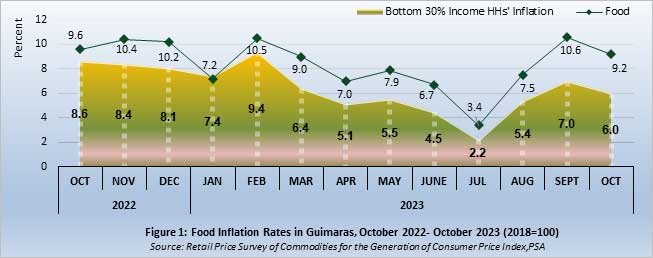
Inflation rate for low-income households (HHs) in Guimaras Province slowed down to 6.0 percent in October 2023 from 7.0 percent in September and 8.6 in October 2022 due to slower retail cost spikes in food items with 9.2 percent inflation.
This is based on the latest price statistics released by the Philippine Statistics Authority (PSA).
“Inflation on Food and Non-Alcoholic Beverages was posted at 8.3 percent, recording a huge share of 67.6 percent in the October headline inflation downtrend. This was followed by Housing, Water, Electricity, Gas, and Other Fuels with -1.2 percent inflation, and Restaurants and Accommodation Services with 4.7 percent inflation, sharing 21.2 and 9.4 percent, respectively to the overall inflation for the bottom 30% income HHs of Guimaras Province,” Provincial Statistics Officer Nelida B. Losare said.

The major source of the slower inflation of Food and Non-Alcoholic Beverages in October came from food items, with 9.2 percent inflation sharing 60.1 percent, which can also attributed to the low cost of rice commodity with 7.5% inflation.
Followed by Other vegetables, fresh or chilled with –12.3 percent inflation, and Cane and beet sugar, with –6.4 percent inflation, sharing 16.7 and 6.0 percent, respectively.
Housing, Water, Electricity, Gas, and Other Fuels’ inflation at –1.2 percent was due to the slower price change of Electricity, Gas, and Other Fuels with –3.9 percent inflation, and the slower inflation of Restaurants and Accommodation Services at 4.7 percent was driven by the Food and Beverage Serving Services, at 4.7 percent inflation.
“In terms of contributions to low-income HHs inflation in October, Food and Non-Alcoholic Beverages still topped the rank with 89.8 percent splits followed by Alcoholic Beverages and Tobacco with 12.0 percent inflation and Personal Care, And Miscellaneous Goods and Services with 11.0 percent inflation posting a significant cut of 7.6 and 5.2 percent, respectively,” Losare said.
The data showed that the major contributor to Food and Non-Alcoholic Beverages’ downward inflation in October still mainly came from food items, sharing 88.3 percent, which can also attributed to the low cost of a Rice commodity with 29.5 percent contribution.
It was followed by Fruit-bearing vegetables, fresh or chilled, with 41.9 percent inflation, and Fish, live, fresh, chilled, or frozen, with 3.5 percent inflation, sharing 12.6 and 6.3 percent, respectively.
Alcoholic Beverages and Tobacco’s inflation at 12.0 percent was due to the slower price change of Tobacco at 12.8 percent, and the slower inflation of Personal Care and Miscellaneous Goods and Services at 11.0 percent was driven by Personal Care, at 11.0 percent inflation rate.
Losare further expounded that the Inflation Rate is the rate of change in the Consumer Price Index (CPI) derived by computing the indices relative to the same period in the previous year or month.
“Currently, the bottom 30% income HHs in Guimaras posted a 127.7 CPI, this indicates that a typical low-income Guimarasnon household needs 1,277 pesos in October 2023 to purchase a basket of goods and services worth 1000 pesos in 2018,” Losare said.
Losare further explained that the inflation rate for the bottom 30 percent of income households, who are the most vulnerable to economic and social difficulties, is being computed to monitor their welfare.
“The classification of the low-income group was based on the relative poverty concept, households whose per capita income falls below the bottom 30 percent of the cumulative per capita distribution,” Losare said.



























